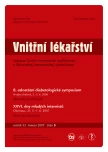Nutrition for diabetics in relation to physical exertion
Authors:
Z. Zadák
Authors‘ workplace:
Centrum pro výzkum a vývoj Lékařské fakulty UK a FN Hradec Králové
Published in:
Vnitř Lék 2007; 53(5): 548-549
Category:
Overview
Metabolic disorders for sugars, fats and amino-acids have a significant influence on the physical performance of type 1 and 2 diabetics. Recent studies have given a great deal of attention to the influence of the entry of fatty acids into muscles and steatosis in skeletal muscles during the onset and development of insulin resistance. Another important mechanism that influences the maintenance of muscle mass and its performance is the transport of magnesium and its availability in muscle tissue. There is a lack of magnesium in the populations of the industrially developed world and its depletion leads to disorders of muscular function, especially in diabetics.
Key words:
diabetes mellitus – nutritional sunstrates – muscular steatosis – fatty acids – carnitine – magnesium 2.
Sources
1. Abate N, Garg A, Peshock RM et al. Relationship of generalized and regional adiposity to insulin sensitivity in men with NIDDM. Diabetes 1996; 45: 1684–1693.
2. Chan JM, Stampfer MJ, Ribb EB et al. Obesity, fat distribution and weight gain as risk factors for clinical diabetes in man. Diabetes Care 1994; 17: 961–969.
3. Consoli A, Nurjhan N, Capani F et al. Predominant role of gluconeogenesis in increased hepatic glucose-production in NIDDM. Diabetes; 1989; 38: 550–557.
4. De Fronzo RA, Bonadonna RC, Ferrannini E. Pathogenesis of NIDDM. A balanced overview. Diabetes Care 1992; 15: 318–368.
Labels
Diabetology Endocrinology Internal medicineArticle was published in
Internal Medicine

2007 Issue 5
Most read in this issue
- Inflammatory diseases of the eye
- Tinnitus and diabetes
- Increased activity of the sympathetic nervous system and the possibilities for therapeutic influence
- Olfaction and gustation in diabetes
